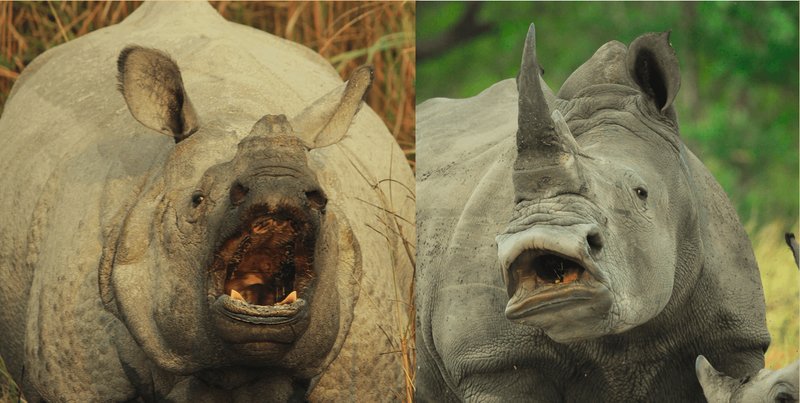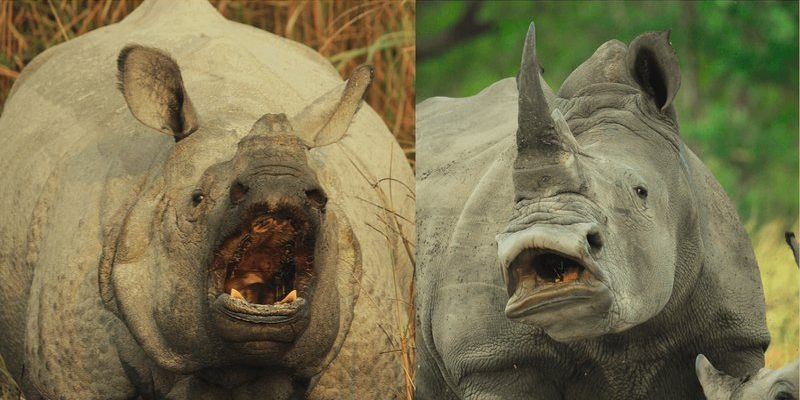
In this article, we’ll dive into ten animals that have similarities with the Indian rhinoceros. From other rhino species to some surprisingly distant relatives, each has its own unique features and adaptations. By the end, you’ll have a better understanding of how to tell them apart and appreciate their distinctiveness. So, let’s get started on this wild journey through the animal kingdom!
The White Rhinoceros
The white rhinoceros is one of the closest relatives to the Indian rhino. It’s larger, weighing between 3,000 to 5,000 pounds, compared to the Indian rhinoceros, which typically weighs around 2,200 to 3,000 pounds. But size isn’t the only thing that sets them apart. White rhinos have two horns, while the Indian rhino has just one.
You might be wondering about the name “white” rhino. Surprisingly, it’s not due to their color, which is more grayish-brown. The name actually comes from the Dutch word “wijde,” which means “wide,” referring to their broad mouths designed for grazing on grass. In contrast, the Indian rhino’s more pointed mouth is adapted for browsing leaves and shrubs.
Both of these magnificent creatures are primarily found in grasslands and savannas, but their ranges differ significantly. The white rhino roams mainly in Southern Africa, while the Indian rhino is native to the Indian subcontinent. This separation highlights the diversity of habitats where these majestic animals thrive.
The Javan Rhinoceros
The Javan rhinoceros is another close relative, and honestly, it’s one of the rarest large mammals on Earth. With fewer than 80 individuals left in the wild, it’s a real conservation concern. Similar to the Indian rhino, the Javan rhino has a single horn and a similar body shape, but it’s smaller and has a more folded skin texture.
One significant difference is their habitat. While the Indian rhino prefers grasslands and wetlands, the Javan rhino is usually found in dense rainforests. Picture yourself wandering through lush, tropical greenery, and you might catch a glimpse of this ghostly creature hiding among the trees.
The Javan rhino’s skin also appears less wrinkled than that of the Indian rhino. If you’re ever lucky enough to spot one, their more subtle skin folds give them a slightly smoother appearance. This is just one of those fascinating distinctions that show how animals adapt to their environments!
The Sumatra Rhinoceros
Next on our list is the Sumatra rhinoceros, another close cousin to the Indian rhino. Standing at about 3 to 5 feet tall at the shoulder, this rhino is the smallest of all living rhino species. While they also share a single horn, their bodies are covered in a layer of shaggy hair, making them quite different from the smooth, armored look of the Indian rhino.
Sumatran rhinos are much rarer and are often found in the dense forests and swamps of Sumatra and Borneo. Here’s the interesting part: they are also known for their vocalizations—these tiny rhinos can produce a variety of sounds that help them communicate with one another. Imagine trying to make sense of a conversation with a friend who had a very different way of talking!
In terms of behavior, the Sumatran rhino is more solitary compared to the Indian rhino, which can be found in small groups. This difference in social structure adds another layer of intrigue to the relationship between these species.
The Black Rhinoceros
Then we have the black rhinoceros, which, despite its name, isn’t really black but more of a slate-gray shade. This species has a pointed upper lip adapted for grabbing leaves from bushes and trees. Unlike the Indian rhino’s more rounded mouth, this feature allows them to thrive in different habitats, from savannas to scrublands.
Black rhinos are generally smaller than white rhinos, but they are quite agile for their size. They can often be seen in a more solitary lifestyle, which can lead to intriguing encounters as they navigate their territory. If you were to spot a black rhino in the wild, you might notice how they often stand still and alert, scanning their environment for any signs of danger.
This species is also critically endangered due to poaching and habitat loss. Understanding their behavior helps conservationists protect them more effectively. Just as you’d want to advocate for a friend in need, recognizing these animals’ struggles can motivate us to support wildlife conservation.
The Cape Buffalo
Although very different from the Indian rhinoceros, the cape buffalo shares certain similarities. Both are large herbivores that live in herds. Cape buffalo thrive in Africa’s savannas, grasslands, and forests, often grazing alongside other animals. While they don’t have horns like the Indian rhino, the buffalo’s formidable horns curve outward and can remind one of a rhino’s horn in appearance.
You might find it interesting that Cape buffalo have a reputation for being unpredictable. They’re known to defend themselves fiercely against predators in a way that can be likened to the protective nature of rhinos. When you see a herd, it’s like watching a tightly-knit community working together to fend off threats.
In the ecosystem, both species play crucial roles in maintaining the balance by grazing and controlling the plant life in their habitats. Think of them as nature’s lawnmowers, helping to create spaces for other species to thrive.
Asian Water Buffalo
Now let’s look at the Asian water buffalo. This gentle giant is often domesticated in many parts of Asia. They share some physical traits with the Indian rhino, such as large bodies and similar habitats. However, they are easily distinguishable due to their large, curved horns and less armored skin.
Asian water buffalo are typically found in wetlands and rice paddies, where they help farmers till the land. Imagine seeing them working alongside harvesters, muddy and content! While they often live in herds, they can also be found alone or in smaller groups, providing a different social structure compared to the more communal rhinos.
These animals have a calm demeanor, contrasting with the often more standoffish nature of wild rhinoceros species. This allows for easier interactions with humans, as they’ve been utilized as working animals for thousands of years.
The Bactrian Camel
While it may seem odd to include the Bactrian camel, this two-humped wonder has a unique connection with the Indian rhino! Both species are well-adapted to harsh environments—rhinos in the heat of the wetlands, and camels in the deserts.
With a robust body and a thick coat, the Bactrian camel can withstand severe temperatures, making it a remarkable survivor. Their ability to store fat and water in their humps is akin to how certain rhinos store fat in their bodies for survival during lean times.
As you visualize these animals side by side, think of them as examples of how different species adapt to their surroundings in remarkable ways, each carving out their niche in the world.
The Tapir
Lastly, we can’t forget about the tapir. These quirky creatures might remind you of a rhino with their similar body shapes and short legs, but they have a more elongated snout that resembles a trunk. Tapirs are mostly found in Central and South America and are excellent swimmers, often seen wading through rivers.
Their size isn’t as daunting as the Indian rhino, but they play a similar ecological role by helping to disperse seeds. Picture a tapir munching on fruit, then wandering off to leave seeds behind—it’s like they’re planting new plants wherever they go!
The tapir’s thick skin and stocky body draw some parallels with the rhino, but their behavior is quite different. They tend to be solitary, which adds a layer of mystery to their existence. Observing a tapir in the wild might remind you of witnessing a shy friend sneaking through a party unnoticed.
As we’ve explored these ten animals similar to the Indian rhinoceros, it’s clear that while there may be similarities in size, habitat, or behavior, each of these creatures possesses its unique traits and adaptations. From the sturdy Javan rhino to the playful tapir, they all contribute to the rich tapestry of wildlife on our planet.
Understanding these relationships not only deepens our appreciation for the diversity in the animal kingdom but also highlights the importance of conservation efforts. Many of these creatures face threats from habitat loss and poaching, just like the Indian rhino.
So next time you think of the Indian rhinoceros, remember it’s one among a family of fascinating relatives, each deserving our respect and protection. After all, they’re all interconnected in this vast web of life, and it’s up to us to help keep that connection strong.

